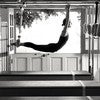Description
About This Video
Transcript
Read Full Transcript
Hey everybody. I'm Jen as a fino. And today I want to talk about the theme of support. So in place, all of us, whether we're students or teachers, we have this wonderful experience with finding the support that translates from inside of our body through the way that we stabilize our skeleton and that we move through space to hopefully our daily lives. And the idea that we all talk about in Claudia's is that we can take the lessons we learn in the studio and bring them to home to work and really implement this sense of feeling supported throughout our life. But today I'm here to ask the question, what if we were to engage in a practice in our daily life that actually completed the circle and brought it back into the studio?
And the idea of this is self support. So a while back I was a practicing a mantra practice and one of the mantras that came up is in order to feel supported, I must support myself sometime in our lives, in our teaching and our movement lives, there's always a gray zone of what am I going to get this right to, when am I going to figure this out? Maybe I have a low energy day or a high energy energy day and sometimes we can just chalk it up to the day going bad. But other times it's because we haven't engaged into some really deeply considerate practices that go towards lighting us up, lifting us up and getting us ready for a movement practice. So today we're going to talk a little bit about that and I'm also going to give you a visualization to help with this exercise of creating some, not only touchpoints or values of self-support that are personal to you, but also starting to create some rituals from them.
So together we're going to, if you're seated, we'll just put the feet flat on the ground or if you are in a more comfortable position laying down. I'd just like you to close your eyes. And if closing your eyes is not comfortable, you can always close them to about one 10th of the distance to closing or open them one 10th of the distance to opening. So from here we'll just settle our breathing and I want you to clear the s the scene in your mind so that there is a blank slate. And I want you to think about a time, whether it's from your childhood or the recent past where you are in a scene where the theme is happiness. So whatever comes to your mind initially, I want you to go there and just start to observe what's happening within that scene. Who, who is in it with you and what is the soundtrack that's going on in the background or there's people's voices.
Is there music cause there sounds of nature and what's the environment that you're in? Are you outside? Are you inside? And start to think about all of the details that go into this scene, including the more specific aspects of what, what actually is going into your happiness in this moment. What's bringing you into an emotional place of ease and contentment and maybe even bliss. And how are these things all related? So we've got our environment where we are, what's going on, kind of objects are in place, got our relationships with perhaps the people that are in the scene with us or perhaps not.
And then finally we've got the energy or perhaps the emotions that are going into the way that we're feeling that help us describe it in a more specific way. And when you are finished, you kind of have picked out everything that you can get out of this visualization. You're just going to open your eyes slowly and it might help to write some of these things down after you've taken a moment to consider them. So what we're going to do is to start to take out some of the themes like the environment, like the emotion, like the feelings and the people perhaps that are involved. And in order for me to clarify this, I'll tell you a little bit about mine.
So one of my scenes is dancing with my son in my kitchen. And so there is an element of warmth there because we're inside of the house and it's cozy. There's an element of play because there are absolutely no rules to what's going on and we're just kind of letting it happen. Uh, there is music and so that's the soundtrack that's happening and there's also laughter and the emotion that I would categorize myself feeling is something like freedom. Like there's a sense of abandonment and just contentment that, that we don't know what's happening next. And as somebody who spends their life, you know, telling people what's going to happen next, this is a really nice break from all of that. So when we establish these themes, we're getting kind of a, a secret stealth recipe for developing some practices that can feed directly back into our, our energetic happenings throughout the day. So for example, uh, one of my themes is music.
And there are times where in my daily life I don't necessarily have the time or I forget to engage in music, but I know that when I do, it lifts me up. It changes my mood, it puts me in a better head space for whatever I'm about to do later on that day. So a ritual that I've created is that I have certain playlists for certain parts of the day that I go to. One of them's called a positive perception playlist, and that's where I go when I might not be such a positive day, I might be stressed out. So I know the songs on that have been handpicked by me with the intention of feeding directly back into that energy of that happiness, contentment, bliss, and that in my brain, by looping those ideas together, I'm engaging into that playlist. I know what the expected outcome is, and I know that by doing that, I'm supporting myself. So for example, when I go to work in the studio in the morning and I listened to that playlist, I get to the studio and I'm pumped up, I'm ready, my energy is high and centered, and I bring in that energy that's specific to me, that's unique to me, into the studio, and I can then give it to my clients. And it's a much more satisfying engagement than say, if I got stuck in traffic and didn't have the upper, didn't, didn't take any time to take care of myself. So the, what you want to do is take these themes and usually three to four we'll have a good indication of of some areas that you can engage into and then start to think of behaviors that you might already be doing. So these behaviors, they should be easy to get into. They should be inexpensive, you shouldn't have to break the bank going to get them. I'm buying things.
There should be things that seem reasonable that you could implement tomorrow. So it's not a longterm plan that you have to really expend a lot of energy in getting into. But these are things that you, you already know work for you and you're going to start to make a connection between these behaviors that you engage into already and these feelings that you know are associated with the time of bliss and contentment. And in doing that, this is a just a really, really simple way to offer ourselves some self support. It's like a high five when you listen to that playlist. Or if I know I've been just concentrating too much on teaching pilates and studying PyLadies that I know I need to let it go and go into a playful mode, um, or maybe teach a playful class and let, let some of that energy come in. So by doing this, we start to support ourselves.
We engage into the energy that helps us thrive. We bring it back into the studio and we can re-engage into that energy through our movement. And then the circles completed. Because once we find that energetic association both inside and outside of the studio, we kind of get a sense for, for what goes into making us tick as people and as movers. And I wanted to offer this as a tutorial because I know that many of my colleagues and many students out there, we're all trying as hard as we can to learn as much as we can to do as much as we can to help as much as we can, either ourselves or other people. And the fact remains that we must also help ourselves in order to be able to help others. We've got a beautiful, strong community and we can only get stronger by stepping forward and saying that I am worth the time that I'm going to spend on a playlist, which really isn't that much time if you think about it.
So I hope you'll take some of these suggestions and try them on for size and support yourself so you can feel supported.
Comments
You need to be a subscriber to post a comment.
Please Log In or Create an Account to start your free trial.




















